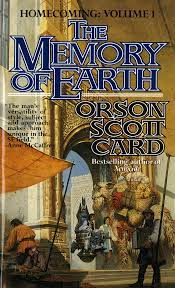Articles/Essays – Volume 25, No. 1
Penetrating the Heart of Mormonism | Orson Scott Card, The Memory of Earth: Homecoming
The Memory of Earth begins the five volume story of the Oversoul, the master computer of the planet Harmony. For forty million years, the Oversoul has preserved peace among humans exiled into space by a nuclear holocaust on Earth.
Aware that its powers are failing, the Oversoul sends premonitory dreams and visions to Wetchik, one of Harmony’s leading citizens. Wetchik’s four sons respond differently to their father’s experiences. The two eldest rebel; the third, crippled and dependent upon technology for his mobility and independence, remains passively loyal. But the fourth and youngest, Nafai, attempts to understand his father’s dreams. His actions set him against his older brothers and against the prevailing mores of the city that is their home, Basilica.
If all of this sounds vaguely familiar, it should. In The Homecoming Card sets himself an ambitious goal: to reproduce as science fiction the overt narrative structure and underlying ethical, moral, and theological conflicts of the Book of Mormon. As he has done superbly in the Tales of Alvin Maker series, his reimagining of the Joseph Smith story in a world of science and religion and magic, Card attempts here to penetrate the surface of religious narrative and analyze the underlying human motivations.
Card insists that his readers recognize both surface and substance when he structures his story in The Memory of Earth on the opening chapters of 1 Nephi. All of the essential elements are here, altered to meet the needs of Card’s imagined worlds yet retaining the force of their narrative and theological meanings. The relationship of Nafai to Nephi is immediately obvious, but Card is careful to distance himself from other specifics of the Book of Mormon narrative. Nafai’s father is not Lehi but Wetchik, a prosperous trader. His older brothers Elemak and Mebbekew parallel Laman and Lemuel in their attitudes but not necessarily in their actions. And—perhaps most intriguing of all—Card’s Sam-analogue, Issib, emerges as a fully rounded character, as capable as Nafai but physically handicapped and totally dependent upon technology or other people.
As The Memory of Earth unfolds, Card systematically lays the foundation for his narrative. Wetchik is warned in a vision to leave the city of Basilica, situated—as was Jerusalem in Lehi’s time—between two rival and warlike nations. His older sons join the opposition party, whose leaders plot to kill Wetchit, while his younger sons struggle to make sense of what is happening. Forced by the unrav eling political situation to flee Basilica, the family camps in the desert, where the father speaks a poem modeled on one in 1 Nephi (identified as a “quellenlied” by Hugh Nibley in Lehi in the Desert), naming the river for his oldest son and the valley for his second son. While in the desert, Wetchik is told that his sons must return to Basilica for the Palwashantu Index—the computer index of the Over soul that holds all memories of Earth—currently in the possession of his arch rival. The four sons return and attempt to buy the Index; ultimately, Nafai slays a drunken Gaballufix and deceives the servant Zdorab into turning over the brass ball.
At this point The Memory of Earth breaks off, having prepared the ground for four subsequent volumes: The Promise of Earth, The Ships of Earth, The Voyage to Earth, and The People of Earth. Card has made clear that he is clothing Book of Mormon narratives and themes in the guise of con temporary science fiction. The Memory of Earth does not strive for the truthfulness of theological assertion, since that level is never in doubt in Card’s fictions; rather it struggles for the truthfulness of human motivation—love, faith, loyalty, greed, ambition, fear, revenge.
In The Memory of Earth, Card creates an alien world with complex ecological, historical, and political backgrounds; with a self-destructive social system based on female ownership of property; and with religious and cultural beliefs central to Nafai’s development and at the same time frequently illustrative of LDS belief. The elements that define the planet Harmony are essential to Card’s narrative, yet they also define our own world, with its often distorted social, sexual, moral, and ethical values.
The Memory of Earth: Homecoming by Orson Scott Card (New York: Tor Books, scheduled for 1991 release).


 Back to full Issue
Back to full Issue

